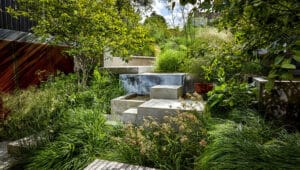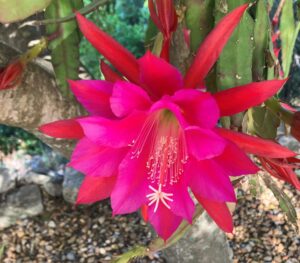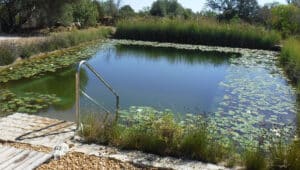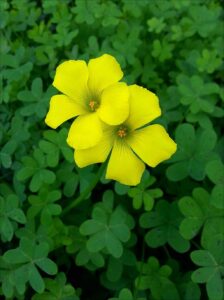In a country where water is scarce and expensive, gardens are full of useful plants: edible, fragrant or medicinal. Making multi-use hedges is a good idea.
However, the traditional choice for defining boundaries in our climate is not a hedge but dry-stone walls; a sustainable investment that produces microclimates that are often welcome. Also be aware that if you don’t have room for a hedge, then using climbing plants is a very good solution. Vines, blackberries or passion fruit (evergreen but short-lived) work well.
The average hedge (height 1.5m to 5 m) is designed to protect from the wind, give privacy, deter intruders and mark the boundary of an area – in other words, to separate and isolate.
If you have a specific problem with high winds, then a windbreak hedge made of Prunus Lusitanica, Portuguese laurel, which accepts pruning, may be a solution, or bamboo hedges though they are rightly considered invasive. There are now non-spreading bamboos, which are an alternative to keep in mind, although none of the above bear fruit.
A useful windbreak hedge can be made with the tea tree from Australia – Melaleuca alternifolia – especially in coastal areas.
Hedges are not without problems. The first is keeping them clean, otherwise they can quickly be invaded by unwanted plants. To avoid weeds, it is essential not to leave the ground bare. Once any irrigation is installed (at least 25cm around plants) cover the soil with permeable landscape fabric and cover with 4cm of gravel. This limits water consumption and weeds and acts as a mulch, keeping the roots cool.
The second problem is that the hedgerows are a pest factory. They are a home for fruit flies that are just waiting to invade your orchard. A prickly pear hedge (Opuntia indica), a formidably defensive hedge and evergreen, is a refuge for medflies (Ceratitis capitata). For the same reason, you can’t use fig or citrus hedges, which is unfortunate because a flying dragon hedge (Poncirus trifoliata var. Monstrosa) would make an amazing defensive hedge.
The third potential problem is winter leaf drop – not desirable. The traditional hedge plant here in the Alentejo and the Algarve is a pomegranate hedge. They are easily pruned to any size, are indifferent to soil conditions and forgive random watering. They are beautiful bushy trees in December with bright orange foliage and, with thorns, they provide protection … but from January to March, they do not stop the view. The dwarf pomegranate can reproduce the gardens of Versailles in our climate; they can be pruned like boxwood. Finally, note that plants that do not like shade at their base (especially olive trees) are automatically excluded.
So here are some interesting possibilities:
1. If you have time to cover your hedge with insect nets during the fruiting period, or protect your fruit in fruit bags, contemporary nurseries offer columnar fruit trees of many varieties that make 2-3m hedges that produce excellent fruit, including apples and pears . This is a quick way to create a low, slow-growing and well-structured hedge. They don’t mind being planted close together and need little or no pruning. They are deciduous.
2. Arbutus hedges (Arbutus unedo) are green all year round and are slow growing, which is a significant advantage – two prunings per year is sufficient. The plants are easy to find and inexpensive. Plant 1m apart and train the hedge by giving it a little more height each year. Only moderate watering is required in the early months. Later irrigation can be removed completely. The fruit is late and does not attract medflies. It is a local plant that is perfectly indifferent to wind and soil conditions. It is a good choice, except that birds will feast on the ripe fruit. Arbutus makes a perfect monovarietal hedge.
3. The service berry (Amelanchier arborea) has small early fruit (May) which are not attacked, except when completely ripe and then by blackbirds. The plant is deciduous and not very compact, but the fruit is excellent.
4. Elaeagnus umbellate, or Japanese silverberries, make wonderful evergreen hedges up to 2m high. They don’t like shade and don’t make a really dense hedge. You can find several varieties, some with very tasty fruit, available commercially.
5. European plums, first and foremost the Mirabelle plum. European plums don’t seem to be affected by medflies and, if they are trained as a bush, they can easily make diverse fruiting hedges. There are good varieties in Italy at Enzo Maioli’s plant nursery: www.maiolifruttiantichi.it
6. Incredibly defensive and very productive with late ripening fruit, the jujube, Ziziphus lotus, can survive without water. They do, however, grow more quickly when watered. They can be reproduced from seed. They are deciduous.
7. Surinam cherry or Eugenia uniflora make an original fruiting hedge in our climate and they have no other enemies than birds and your visiting friends. The Eugenia is available widely. In acidic soil and in a shady spot, it’s worth trying a fruiting fuchsia which aren’t prey to anything but mildew.
Mixed hedges that give a less formal aspect are not the custom in our climate. The Nordic taste for abundant green is not the tradition of fruiting Mediterranean gardens, which are conceived as a world apart to a natural environment that can appear desert like.
In Portuguese garden history, there is a division between the pleasure gardens and those for food production. However, in organic and permaculture systems, fruiting hedges are encouraged as part of the ‘food forest’ approach to maximising production with minimum inputs.
Your local monthly markets are a good place to start looking for local fruit varieties to make your fruity hedging.
By Jean-Paul Brigand
|| features@algarveresident.com
Jean-Paul Brigand – olharfeliz.typepad.com
Mediterranean Gardening Association – Portugal | www.mgaportugal.org































